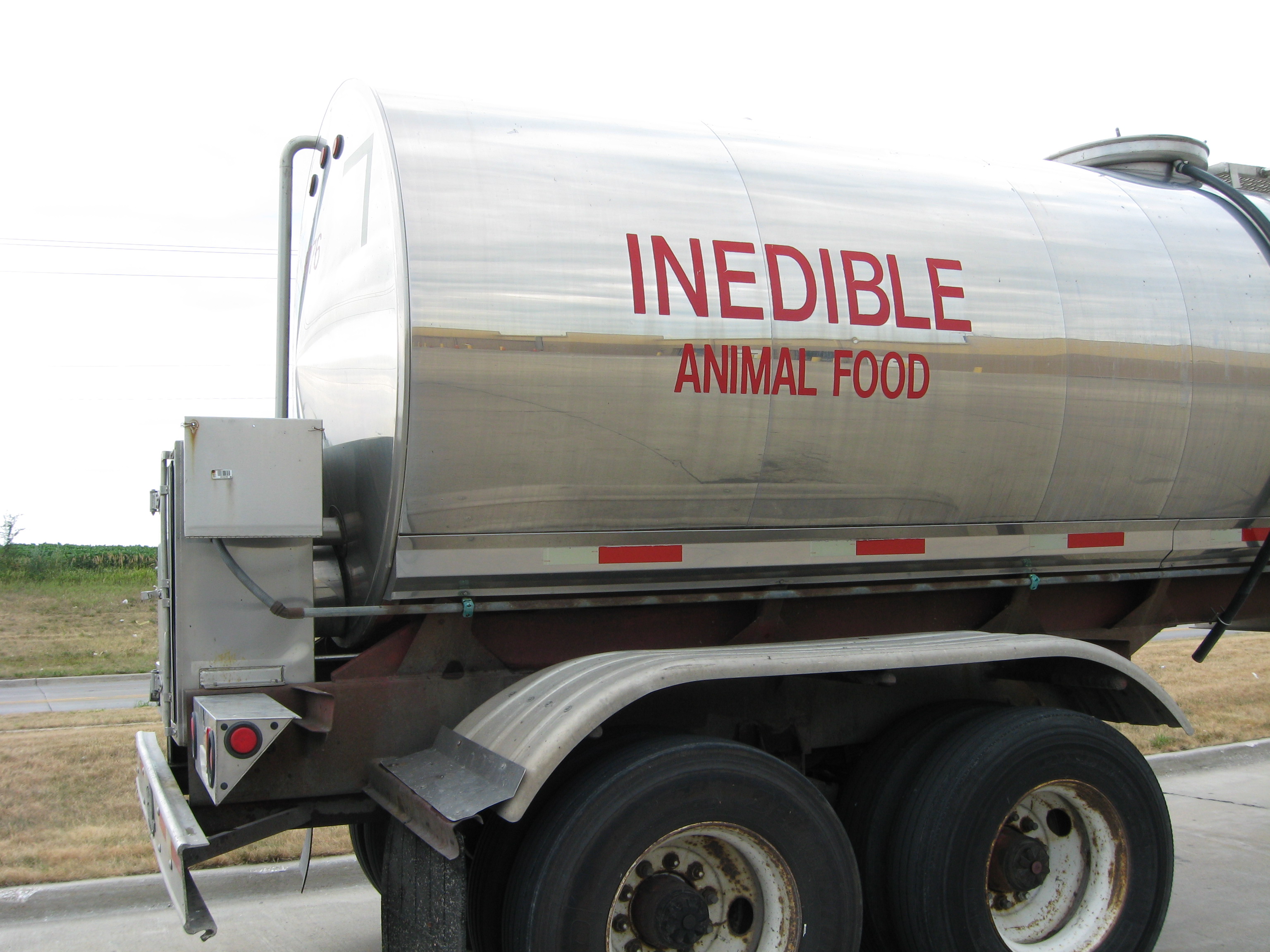Pictures speak a thousand words. The following pictures were provided by one of you wonderful pet food consumers out there – from a recent trip to Fort Dodge, Iowa. Right from the Purina plant, “Inedible Animal Food.”
If you look at this image closely, you’ll see tanker trucks parked inside the Purina plant property…
But this wonderful pet owner – that provided these pictures – didn’t want others to miss what was stated on that tanker truck. So she took a close up of the tanker itself (that was parked inside Purina property)…
Yes. “Inedible Animal Food” inside a pet food plant.
So what is “inedible animal food”?
Within U.S. federal regulations, there is no definition of ‘inedible animal food’. Basically, inedible animal food is ‘inedible’ for human consumption foods. The Code of Federal Regulations (CFR) defines ‘inedible’ as: “Adulterated, uninspected, or not intended for use as human food.”
Canadian regulations state “Inedible products include products which are, by their very nature, inedible (i.e. feathers, hides, hair), condemned, “previously edible” materials which have been condemned, and specified risk material (SRM) which includes recovered solids from waste water, on their premises, as prescribed in Section 28…”
To give a little more insight into exactly what ‘inedible animal food’ could include, the (U.S.) Code of Federal Regulations (CFR 314.10) titled “Livers condemned because of parasitic infestation and for other causes; conditions for disposal for purposes other than human food” states (bold added):
“(b) Livers condemned because of parasites other than hydatid cysts; and livers condemned because of telangiectasis, angioma, “sawdust” condition, cirrhosis, carotenosis, or other nonmalignant change, benign abscesses, or contamination,…may be shipped from an official establishment only for purposes other than human food…”
“(c) Livers condemned because of conditions described in paragraph (b) of this section shall be in containers plainly marked “inedible”.”
And federal law is concerned with the risks associated with ‘inedible products’. The law is clear no diseased animal or diseased animal tissue (inedible) should come in contact with USDA inspected and approved products. “Handling and Disposal of Condemned or other Inedible Products at Official Establishments” (Title 9, Part 314.8 b Dead animal carcasses)…
“Under no circumstances shall the carcasses of any animal which has died otherwise than by slaughter, or any part thereof, be brought into any room or compartment in which any edible product is prepared, handled, or stored.”
To be fair, all ‘inedible’ products are not diseased animal parts. Parts of a slaughtered animal that are not commonly consumed by humans – such as internal organs (but including intestines) could also be considered inedible. But significantly important, federal regulations do not require these types of inedible products to be “plainly marked inedible”. Only diseased animals or filth contaminated products must be “plainly marked inedible”.
‘Inedible’ products can be shipped directly to pet food manufacturers or these products can be sent to rendering facilities to be processed into various pet food ingredients. There are federal regulations governing the transportation of this material as well. “325.11 Inedible articles: denaturing and other means of identification; exceptions” states “tank cars and trucks” containing inedible products shall be clearly marked as “inedible”. The law even goes into great detail of how high the letters marking ‘inedible’ must be and expands into requirements to providing a clear background behind the ‘inedible’ markings.
Yes, there are laws against the use of condemned material in pet foods. Federal law clearly defines ‘food’ to include animal foods. Chapter 9 Federal Food, Drug, and Cosmetic Act Chapter 9 321. Definitions defines food as…(bold added)
“(f) The term “food” means (1) articles used for food or drink for man or other animals, (2) chewing gum, and (3) articles used for components of any such article.”
And federal law defines an adulterated food (and thus prohibited) Chapter 9 – 342. Adulterated food: “if it is, in whole or in part, the product of a diseased animal or of an animal which has died otherwise than by slaughter.”
Inedible is a violation of federal law in all foods – human or animal.
Why isn’t federal law being enforced with pet foods? Why are “inedible animal foods” allowed to be processed into pet foods without the very same clear marking – the required Inedible marking- on the pet food packaging?
Pet food consumers deserve to be informed of what they are purchasing. If ANY ingredient within that food or treat was required to bear the Inedible marking, the pet food/treat should bear the same Inedible marking. The law is the law…except with pet food.
Many, many thanks to the pet owner that provided these pictures!
Wishing you and your pet(s) the best,
Susan Thixton
Pet Food Safety Advocate
Author, Buyer Beware
Co-Author Dinner PAWsible
TruthaboutPetFood.com
PetsumerReport.com
What’s in Your Pet’s Food?
Is your dog or cat eating risk ingredients? Chinese imports? Petsumer Report tells the ‘rest of the story’ on over 2500 cat foods, dog foods, and pet treats. 30 Day Satisfaction Guarantee. www.PetsumerReport.com
Have you read Buyer Beware? Click Here
Cooking for pets made easy, Dinner PAWsible
Are you subscribed to Truth About Pet Food Newsletter? Click Here to subscribe
Follow Truth about Pet Food on Twitter
Become a Fan of Truth about Pet Food, Dinner PAWsible, Buyer Beware on Facebook
Find Healthy Pet Foods in Your Area Click Here








































Pingback: My mother feeds begin strips and is denial that they are bad for her dogs...... - Page 3 - Maltese Dogs Forum : Spoiled Maltese Forums
Pingback: Pet food's darkest secret: Chemically denatured condemned and inedible material | Poisoned Pets
Jessica cribb
August 22, 2024 at 8:57 am
This signage is very misleading and would be helped by warning INEDIBLE in red and perhaps the ANIMAL FOOD words in a different color. Message would make more sense to everyone who can read and even those who can’t understand RED as a WARNING COLOR to stop. Just my opinion. 😉